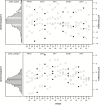Measuring Awareness of Age-Related Change: Development of a 10-Item Short Form for Use in Large-Scale Surveys
- PMID: 29401221
- PMCID: PMC6524483
- DOI: 10.1093/geront/gnx213
Measuring Awareness of Age-Related Change: Development of a 10-Item Short Form for Use in Large-Scale Surveys
Abstract
Background and objectives: Existing measures of subjective aging have been useful in predicting developmental outcomes. Unlike other constructs of subjective aging, Awareness of Age-Related Change (AARC) focuses on how adults' self-perceptions of aging result in an awareness of age-related gains and losses. We developed a 10-item short form (SF) of the existing 50-item AARC questionnaire as a reliable, valid, and parsimonious solution for use primarily in large-scale surveys but also in applied contexts.
Research design and methods: AARC was assessed in a German and North American sample of 819 individuals. Item selection for the suggested AARC-10 SF was based on multidimensional item response theory (MIRT). Multi-group confirmatory factor analysis (CFA) was used to test for measurement invariance (MI) across groups of participants in middle age (40-69 years), early old age (70-79 years), and advanced age (80+ years). Concurrent and discriminant validity in old age was assessed with regard to established measures of subjective aging, well-being, and health.
Results: The AARC-10 SF showed adequate fit to the data and reliability for the perceived gains and losses composites. Valid comparison of latent means was confirmed for early old and advanced age respondents and with some reservation also for middle-aged individuals due to partial MI. Concurrent and discriminant validity were confirmed.
Discussion and implications: The proposed AARC-10 SF offers an economic device to measure AARC and use the construct as an antecedent or outcome in the context of substantive model testing in large-scale survey data.
Keywords: Adult Development; Multidimensional Item Response Theory; Self-Perceptions of Aging.
© The Author(s) 2018. Published by Oxford University Press on behalf of The Gerontological Society of America. All rights reserved. For permissions, please e-mail: journals.permissions@oup.com.
Figures

References
-
- Baltes P. B., Lindenberger U., & Staudinger U. M (2006). Life-span theory in developmental psychology. In N. Eisenberg & W. Damon (Eds.), Handbook of child psychology. Vol. 3. Social, emotional, and personality development (6th ed., pp. 569–664). Hoboken, NJ: Wiley; doi:10.1002/9780470147658.chpsy0111
-
- Barak B. (2009). Age identity: A cross-cultural global approach. International Journal of Behavioral Development, 33(1), 2–11. doi:10.1177/0165025408099485
-
- Barrett A. E. (2003). Socioeconomic status and age identity: The role of dimensions of health in the subjective construction of age. The Journals of Gerontology Series B: Psychological Sciences and Social Sciences, 58(2), 9 doi:10.1093/geronb/58.2.S101 - PubMed
Publication types
MeSH terms
Grants and funding
LinkOut - more resources
Full Text Sources
Other Literature Sources
Medical

